[ Home | Staff
& Contacts | HiFi
Playground | Listening tests | DIY & Tweakings | Music & Books ]
SigTech AEC-1000 Room Acoustics Equalizer

[Italian
version]
Product: SigTech AEC-1000 digital time-domain room and speaker
equalizer
Manufacturer: Cambridge Signal Technologies, USA
Approximate
price: ECU7000 (cheaper versions are available)
Where
conventional Hi-Fi goes wrong...
At my own audio website, Visions in Audio, I
have an article describing the ways stereo recording utilises to fool us into
hearing a more-dimensional sound stage. In short, these are the contents of that
article:
... Within the constraints of the stereo triangle,
instrument lateral positioning is encoded: by the fact that we use two
microphones, two loudspeakers, and two ears, both our ears' lateral positioning
mechanisms, loudness difference and phase (or time) difference, are exercised.
Instrument depth is conveyed in quite a different way. Indeed, while it is still
unclear how depth is reproduced in stereo, we know for sure that tonal accuracy
is a parameter here. A harsh and distorting system surely sounds upfront and
in-your-face, while a laid-back, dull system sounds remote and far-away.
Therefore, speakers lacking utter timbral neutrality can not convey depth. And
if they seem to do, then that depth is purely an artefact of the record/replay
system. Other aspects also play a role in conveying the second dimension, room
reflections being one of them, but quite how it all is interrelated still
escapes us. Suffice to say that all too often in a hifi system, image depth is
more a matter of luck than of consistent qualities of both encoding and decoding
chains, software and hardware. How about the third dimension? Well, image height
is totally lost, as there simply is no mechanism in stereo to transfer it. Some
discs do exhibit marked height-effects, but then these sounds are
purely synthesized and based on psycho acoustics. In other words, these sounds
are not the result of a "pure" record/replay process.
Now summarizing,
to approach an ideal reproduction using the stereo system, one needs neutral
loudspeakers which are positioned in a room that does not add any sonic
signature of its own. No such living room exist, and all of them add standing
wave colourations, early reflections, and a reverberant tail of their own.
Standing waves colour the bass significantly. Early reflections can be likened
to 'parasitic loudspeakers' sitting in the walls. If they arrive at the listener
within a few tens of milliseconds from the direct sound, then they damage the
timbral perception of recorded sounds, and they also harm the localisation of
instruments in our already narrow and precious stereo image.
Moreover,
loudspeakers themselves are a few orders of magnitude less accurate than
microphones (i.e. they colour), while their off-axis responses also differ
widely from those of the recording transducers.
In order to achieve what
is possible within the framework of stereo, we need:
- neutral speakers for timbral accuracy and depth.
- identical speakers: a level difference of a fraction of a dB already warps
stereo.
- a perfectly symmetrical positioning of speakers and listener: an
inter-channel delay of 0.2 milliseconds shifts its source by 10 degrees in the
60-degrees-wide stereo image. 0.2ms amount to a distance of only 7
centimeters, which gives you a fair idea of the accuracy required when
positioning speakers!
- no early reflections (this affects room design, speaker design, and
speaker/listener positioning).
- no standing waves (this affects room design and speaker positioning).
- an evenly reverberant room, at 0.4s for the midband.
We
can say, based on experience, that conventional stereo systems (call them
high-end if you like) only get to a 50-60% approximation of what is possible
with stereo. Die-hard audiophiles then occupy themselves with component choice,
cables and other delusive tweaks to obtain gains that are, on the full scale,
only a few % at best.
Room treatment and optimal loudspeaker and
listener positioning can give perhaps 10-20% towards the ideal. But 100% will
never be achieved with our current means.
However, digital signal
processing can help here. So-called time domain digital acoustics correctors, a
rare and expensive breed of animal, can flatten the direct sound from a pair of
speakers to within 1dB at the listening position. It also can remove room
effects in the critical time window of 50ms after the onset of the direct sound.
Such a machine can implement our whishing list from above, without touching the
rest of the system or the room!
DSP To The
Rescue!
With the arrival of cheap, yet powerful, digital signal
processors (DSPs) things have become possible which were utterly infeasible
before. For, while complex signal processing in the analogue domain is very
cumbersome and also does a lot of harm to the precious audio signal, digital
signal processing does not kill quality - once you're in the digital domain -
and is rather simple, or at least is categorized under exact
sciences/applied mathematics/signal theory.
Brute force computing
enables one to feed the speakers with a pre-compensated signal rather than with
the raw music signal from the source. This pre-compensation, in combination with
the speakers' and room's deficiencies, then assures that the final signal
reaching the listener is entirely devoid of errors, as if a perfect
loudspeaker is used, in an inexistent room.
Such a method was
conceived during the late seventies, at the Acoustic Research company in the
USA. Meanwhile others have jumped on it too, so far with only experimental
systems (B&W room correction, JM-Lab and Celestion with digital
pre-correction for their speakers) or with systems with limited commercial
availability (NAD/TACT and Meridian room equalizers, Philips, Meridian and Revox
digital-active speakers). Yet, these devices never made much of an impact in the
high-end scene... About the only manufacturer who makes these machines and knows
how to sell them - to the professional segment of the market - is SigTech (aka Cambridge Signal
Technologies). With reason: SigTech is in fact an offspring of AR, having
continued the basic research into digital room and speaker correction, and more
importantly, having filed enough patents in the area to make it their
competitors real hard.
The SigTech
AEC-1000
The AEC-1000 Acoustic Environment Correction system is
a digital equalizer, targeted at the professional studio and auditorium markets
(a domesticized version exists, though). The device is to be put between a
digital source on the one hand, usually a CD-transport, and a DAC on the other
hand. For this task it comprises digital I/O in the coax S/PDIF, Toslink and
AES/EBU formats. Should you want to interface in the analogue domain, e.g. using
it in an amplifier's tape or processor loop, internal 18 bits ADCs and DACs do
the job for you.
Inside the SigTech's utilitarian box houses a big and
powerful computer, running software for real-time correction of your speakers
and listening room. There are provisions for four correction algorithms - for
instance for different speakers, or for various listening positions - which can
be switched on and off with a large, wired remote control. During system setup
and calibration two more components are needed: a precision condensor
microphone, and a laptop PC for running the required filter synthesis software
and downloading it to the AEC-1000. Both these items are not delivered by
SigTech, as the calibration procedure normally is done by your dealer or
distributor. Yours truly, being no sissy when it comes to machines, be they of
the digital or the analogue persuasion, did everything by himself during the
three weeks he had the Siggie at home...
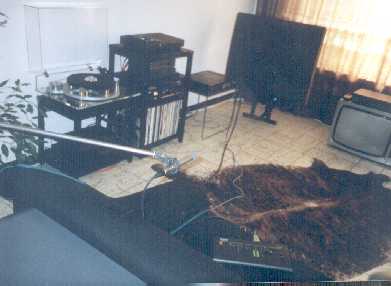
A
room, Quad speakers, SigTech computer, and Schoeps microphone. The turntable
remained unemployed in this digital-only experiment!
Well
then, what does it comprise of, this calibration procedure? During setup the
SigTech functions as a signal source, emitting pulses alternatively to
the left and right speakers. These pulses are again measured by the Sigtech via
a microphone at the listening position, i.e. after they have been through the
whole system and after they have undergone degradations courtesy of the
electronics, the speakers, and finally the room. Provided you take a good one,
the microphone is not a limiting factor. In our case it was an omnidirectional
Schoeps which probably cost just as much as my whole system.
Now back to
the pulse sounds. An infinitely fast impulse may seem to be a very simple
signal, but in fact it is utterly complex, theoretically carrying overtones
(harmonics) up to infinity. As such, impulses are very good at exercising
transducer systems, and at characterising them by virtue of the systems' impulse
response, or the waveform resulting from sending a known impulse
through the signal path.
The picture below may clarify a few things.
It is the impulse response of an ordinary two-way cone/dome speaker box, mounted
on a stand at about 1 meter height, and positioned well off the walls. The
response was taken at a normal listening position, 2.5 meters from the
speaker.
The first impulse at 1 ms is the direct sound from the speaker,
being in fact the signal from the audio system's electronics, but already
distorted by the loudspeaker; the impulse at 2.7 ms is the first reflection off
the side wall, and as you see it is even more distorted. Moreover, it is in
amplitude still 30% of the original signal's loudness (only 10dB down), and as
such it has to be clearly audible. Can you imagine what the influence of such a
distorting parasitic loudspeaker on the sound quality may be?
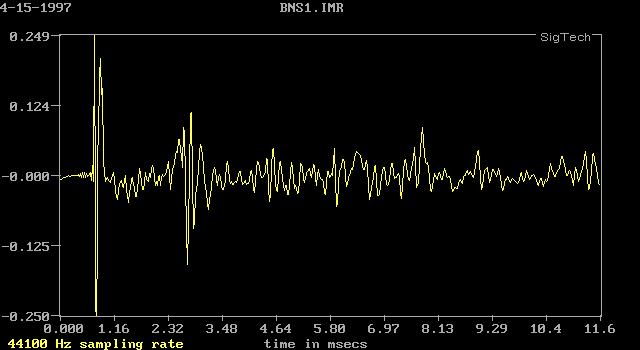
Direct sound
and early reflections caused by a 2-way box speaker positioned in an ordinary
living room.
After the Siggie has recorded the impulse
response of your system, it calculates a correction waveform, this essentially
the desired or perfect impulse minus the response of the system. Around this
waveform then is synthesized a complete filter algorithm or computer program
that, downloaded into the AEC-1000, continuously multiplies the incoming music
data with the correcting waveform. This is in fact equivalent to a time-variable
graphic equalizer with 200 frequency bands per channel. As a result of these
complex actions, the system's amplitude frequency response and phase frequency
response (or time alignment) are linearised at the listener's position. Room
reflections are cancelled too, insofar these reflections in the room are
correctible. (That not all of the reflections can be eliminated is not a
drawback of the SigTech, but is more like a physical property of certain types
of reflections. In other words, no machine will ever be able to compensate for
them.)
That's it. Or is it? The above scheme hides one snag. It
compensates for the sound system's faults at one specific listening procedure.
In order to do this it lets the speakers produce simultaneously music and
correction signals. Now, what would these corrections signals sound like when
listening from an other position? Got it?
System
Specifics
Being a bit lazy I was really not willing to totally
rebuild my system around the AEC-1000. Instead I opted for the easy way: the
Rega Planet served as a transport, piping data through an ordinary cheap
analogue interconnect into the SigTech processor. From there I took the
digital output over a teflon- dielectric solid-core 75 Ohms video cable and then
into a Sony DTC-690 DAT machine, which - set to recording mode - served nicely
as a DAC. The rest of the system was standard: Quad 34, 306, and ESL speakers on
their stands.
Alternatively I tried an older pair of cheap box speakers, the
BNS Quintets.
Now before all of you audiophile paranoiacs turn jittery, I
have to explain that that stupid interconnect in the digital signal path makes
no damn difference, as long as no data are lost. Jitter is not an issue on the
Rega - SigTech link, as everything has to go through a bank of processors
anyway, each running nicely at its own speed. Hence my apparent defiance of hifi
lore...
Final analysis
And so we start
analysing my faithful born-in-1976 Quad electrostatics. Now, knowing that these
are dipole speakers - in the bass and midrange, that is - positioned about 80
centimeters in front of a wall and window, we can easily predict how they would
behave sonically. The out-of-phase backwave from the speakers bounces off the
back wall and combines with the direct sound after passing through the speaker's
diaphragm. For a half-wavelength of 2x80=160 cm, corresponding to 106Hz, this
combination is additive, causing a pronounced peak at that frequency. For a
full-wavelength of that 160 cm, or 212 Hz, the interference is negative,
resulting in a sharp dip there. Well, that's what my pocket calculator says. How
about the SigTech's opinion, based on measurements?
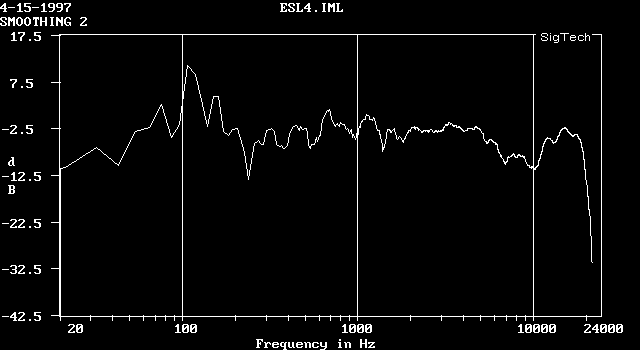
In-room
frequency response of the Quad ESL speaker.
Ha, isn't
science wonderful? It predicts there is a problem, and then it shows you
unmistakably there is a problem! Sadly, I have to stick to this speaker setup
for as long as we're in a small living room, and so I have to endure the
resulting sonic signature: thick and lumpy bass, and a thin, bodyless lower
midrange, all courtesy of the room, not of the speaker!!
But see, even if
I were a total nitwit in acoustics, the SigTech would have told me now where
things go wrong. And this would enable one to act accordingly, modifying the
speaker setup or the room layout. And so a SigTech processor can contribute to a
dramatically improved sound, even when it is not in use!
But we are here
to test the thing employed, so, on with the show...
Listening
with the electrostatic speakers
Reviewers often use words like
'neutrality', 'detail', 'imaging', 'microdynamics', etc. I dare say now that, if
they never experienced a system like this, they don't even know the true meaning
of these words. Switching on the AEC-1000 was like lifting the proverbial veil.
But for real, this time. Not as part of a writer's hyperbole. As if, with the
flick of a switch, you go from a crappy picture taken with a cheap digital
camera to a colour print on large paper, taken with a mid-format Hasselblad: The
SigTech pretty much killed-off my system as I knew it, raising an aural phoenix
from its ashes, one that sounded not unlike gigantic Stax headphones. But better
still.
Imagine a laaaarge soundscape, from the left wall to the right
wall, sounding utterly consistent from the bass limits of the speakers (70Hz
with the ESLs) right up to the edges of audibility. The speakers acting as a
whole, without any feeling of the artificial dissection even the best normal
designs still feature between their various drivers. And moreover, both speakers
sounding completely identical, so that the stereo image not only is extremely
wide, but also has enormous spatial resolution and detail.
Instruments
and voices sounded totally at ease, each in its own position, not crammed on top
of each other and not with one shouting over the other. These sounds just
co-existed, without mutual influence, completely detached from the
music reproducing system, and seemingly even from the music reproduction process
itself. Yes, that's where I am leading at: the SigTech made the music sound so
much more like real music - with all of its intricacies often lost in ordinary
systems - and so much less than a bunch of components trying to sound like the
real thing.
Switching the AEC-1000 off then brought the real shock: thick
sound, lack of rhythm, a nasal quality to the midrange, and much less specified
imaging. After this I only wanted to switch back to the corrected sound as quick
as possible. And once there again, I only wanted to play music, and music and
music...
Which is exactly what I did. For many hours, and often deep into the
night. And that because music, when experienced this way, is very
addictive.
Oh, and lest you would think this computer-based business
is overtly clinical or revealing - in the wrong ways - then be assured that
pretty much all of the CDs I threw at it ended up sounding good, even terminally
compressed and dulled ones like Heather Nova's. This makes you think about the
established hifi rules, not?
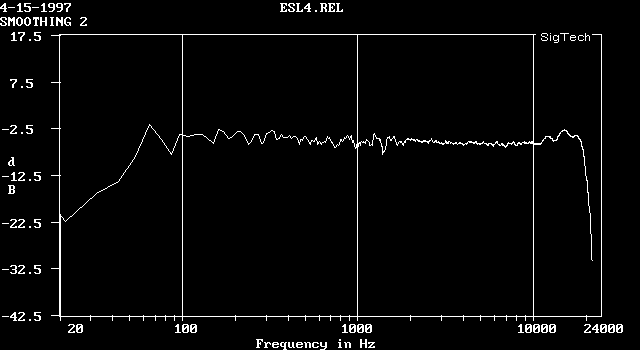
SigTech-corrected
in-room frequency response of the Quad ESL speaker.
Was
it all perfection then? Of course not. I have a few gripes with the sound I
heard. Minor gripes, as they can be compensated for.
The overall sound
balance was a bit bright. But then, the SigTech as installed equalized for a
ruler flat response, which is often not desirable in a living space.
Instead, it can be programmed for a slight downtilt above 4kHz or so. My version
of the software did not support this, or perhaps I was just to dense to provoke
this functionality from the system, so I had to manage with just the one
reference response.
Another thing was an apparent lack of depth in the sound
stage. But as you already read earlier, most stereo recordings don't even
contain real and correct depth information, which is kind of consistent with my
findings. Further, I was playing through the Sony digital-to-analogue convertor,
and that one really is not a reference when it comes to musicality and
other audiophilistic parameters.
How the position-dependency? Aha! That's
the curious part. SigTech have done a great job with this one, as while the
sound when listening close-up to the speakers (between 1 and 1.5 meters) was
positively funny, lumpy, and phasey, the sound field when listening in the large
zone behind my listening chair was still pretty good. And by all accounts better
than the uncorrected sound.
Listening with cheap
cone-and-box speakers
My old BNS speakers cost about ECU450 way
back in 1989. They are mid-sized stand mounters employing a soft-dome Audax HD25
tweeter, and a bright-yellow Kevlar® Audax/Siare woofer. There's also a passive
radiator, aligning the box to something like a damped ported design.

A
blast from my past, and a pain to my ears...
Their sound au
naturel? Well, these must have been one of my biggest hifi mistakes ever
(together with the Linn Axis turntable). Dry, verging on the harsh, without any
real bass to speak of, and in my large listening room also without much stereo
to speak of: there's left, then a hole, CENTER, again a hole, and right. Imagine
the sound of giant telephone horns. That's about it.
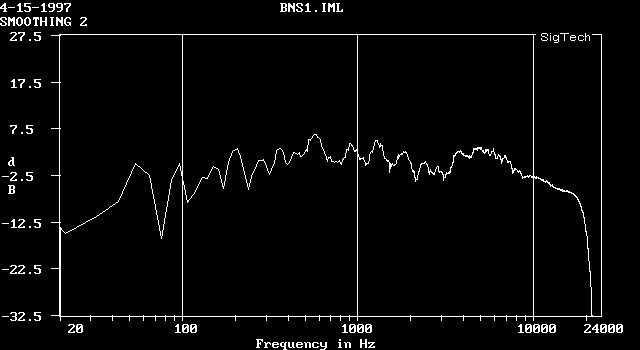
In-room
frequency response of the BNS Quintet speaker.
That's it
until you drive them from a box full of silicon thingies. Believe it or not -
you'd better do, though - but after engaging the SigTech there was
stereo width, wall-to-wall. And there was a proper bass. And warmth.
And neutrality throughout. In fact, the DSP-driven BNSs managed to sound
significantly better than the Quad ESLs used without DSP, bar a residual
dryness. And yes, they were almost as addictive as the ESLs with SigTech. If
anyting, they even beat the latter in bass slam and overall loudness. This just
to prove that if you throw sufficient computer power at a crappy system, it
shall sing, in the end!!!
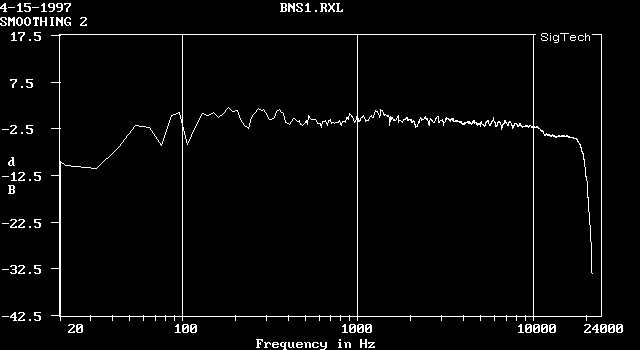
SigTech-corrected
in-room frequency response of the BNS Quintet
speaker.
Conclusion
The
AEC-1000 has been around for quite some years now. If you survey the US press,
you're bound to find a few positive reviews of it there. But the funny thing is
that if you look into UK reviews, you find the SigTech (and like systems)
slammed! I've read comments along the lines of "...only a subtle change, not
even a real improvement" and "...my wife - a dancer - asked what the hell I did
to the system...". Could it be that these reviewers felt that - for their own
mental health - they had to turn down this wonderful component, to fight a
beginning habit, to kill the desire for a product they couldn't afford, a
product that threatens the concept of high-end itself? Because I, for sure,
almost endured a physical and psychical pain the days after the AEC-1000 left my
system...
I've heard the future, and it looks entirely
unlike the past.
© Copyright 1998 Werner Ogiers for
TNT-Audio (www.tnt-audio.com).
Robert Greene's comment
This is Robert Greene here (REG of The Absolute
Sound). I just wanted to tell you how much I enjoyed your review of the Sigtech.
As one of the US reviewers that you mention that has given it (very) positive
appraisal, I have often felt a little as if I were alone with this view,
something like the man on the Hyde Park soap box in the old Punch cartoon who is
being listened to by no one while all the people are listening to the next guy
over, and the lonely speaker is saying "Yet how is it that these vital facts are
virtually unknown in this country today???".
After reading your review, I
feel less like this!! Nice work, indeed.
Robert Greene - The Absolute Sound
DuPont™ and KEVLAR® are registered trademarks or trademarks of
DuPont or its affiliates.
[ Home | Staff
& Contacts | HiFi
Playground | Listening tests | DIY & Tweakings | Music & Books ]








